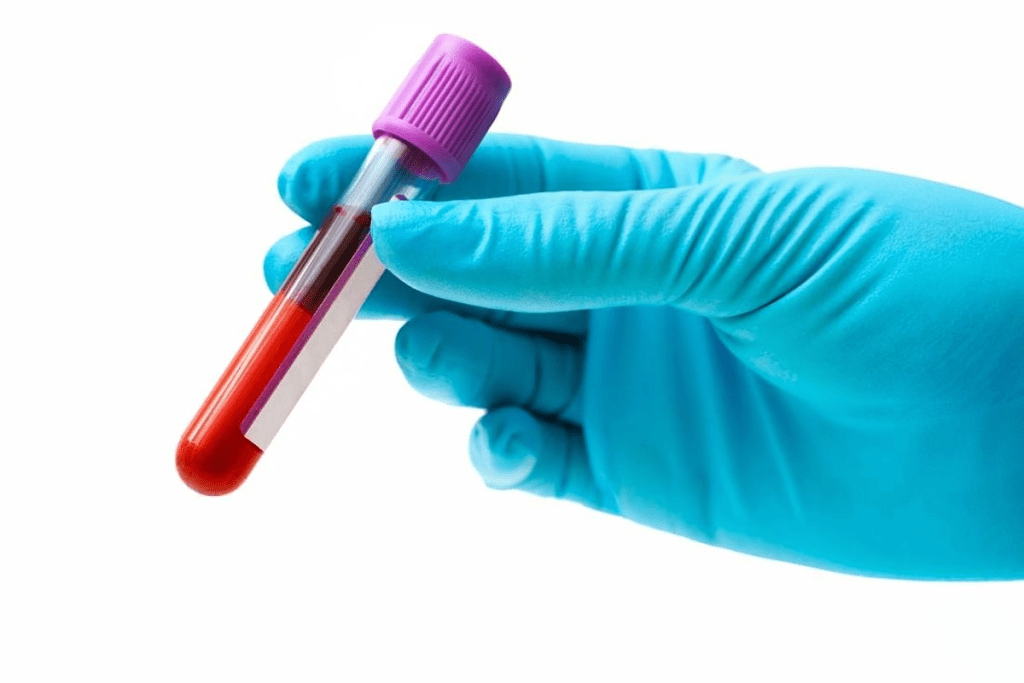Last Updated on November 14, 2025 by

Diagnosing leukemia starts with a visit to a family doctor or a routine blood test. It’s important to use detailed diagnostic methods for accurate diagnosis and treatment planning.
Our team combines traditional and advanced technologies for care. This includes blood tests like Complete Blood Count and microscopic evaluation. We tailor care to each patient.
Getting the diagnosis right is key. It helps us know the leukemia subtype and prognosis. This lets us create specific treatment plans.

Leukemia is a complex blood cancer that affects the blood and bone marrow. It’s a big challenge for doctors to diagnose and treat. Leukemia happens when white blood cells, key to our immune system, grow abnormally.
Diagnosing leukemia is more than just finding the disease. It’s about knowing the exact type and its details. This information is key to creating a good treatment plan.
There are many types of leukemia, each with its own traits and treatment needs. The main types are:
Knowing the exact type of leukemia is vital for the right treatment. At our place, we offer top-notch care. We use advanced tests to make sure we diagnose and treat each patient right.
Finding leukemia early is key to better treatment results. Early diagnosis means starting treatment sooner. This can lead to better survival rates and quality of life.
We use the latest diagnostic tools to catch leukemia early. This way, we can give our patients the best care. By knowing the leukemia type and details, we can make treatment plans that work best for each patient.

The journey to diagnose leukemia starts with a simple blood test. Blood tests are the first step because they quickly check a patient’s health. They can spot signs of leukemia without being too invasive.
We look at blood’s different parts, like white and red blood cells, and platelets. A Complete Blood Count (CBC) is key in this early check. It tells us about the cells’ numbers and quality, helping us find any oddities.
A CBC is a basic test that can show if blood cell counts are off. This might mean leukemia. We check:
If any of these numbers are not right, we might need to do more tests to confirm leukemia.
We also do a Peripheral Blood Smear test. This involves spreading blood on a slide, staining it, and looking at it under a microscope. It helps us:
This test can show early signs of leukemia, leading to more tests.
Both CBC and Peripheral Blood Smear are key for spotting odd blood cell patterns. We look for:
By checking these things, we can see if more tests are needed to confirm leukemia. Finding it early is key for starting treatment quickly and helping patients.
To diagnose leukemia, doctors use bone marrow tests. These tests help understand the bone marrow’s health and its link to leukemia.
Bone marrow aspiration removes a liquid sample from the bone marrow. A needle is inserted into the hipbone or a large bone. The sample is then checked under a microscope for abnormal cells.
The aspiration process is quick and done with local anesthesia to reduce pain. It helps us find leukemia by analyzing bone marrow cells.
A bone marrow biopsy takes a small bone tissue sample. It gives a detailed look at the marrow’s structure and cell distribution. The biopsy is key to diagnosing leukemia types and disease extent.
The biopsy technique uses a bigger needle than aspiration. It’s also done with local anesthesia. The sample is then examined under a microscope.
Examining bone marrow samples under a microscope is key to leukemia diagnosis. It checks for any leukemia cell presence in the samples.
Through microscopic evaluation, we can find the leukemia type and its severity. This info is vital for creating a treatment plan that fits the patient.
By combining aspiration, biopsy, and microscopic results, we get a full picture of the patient’s condition. This approach is key for accurate diagnoses and treatment plans in leukemia care.
Advanced diagnostic methods are key to accurate leukemia classification and treatment planning. At our institution, we use the latest technologies to diagnose and classify leukemia. This ensures our patients get the best care possible.
Immunophenotyping through flow cytometry is a vital tool for identifying specific proteins on leukemia cells. It helps us classify leukemia into different subtypes based on cell surface proteins. Flow cytometry analysis gives us important details on cell lineage, maturity, and clonality. This information is essential for diagnosing various leukemia types.
We use a panel of antibodies to accurately diagnose and sub-classify leukemia. This information is vital for determining prognosis and guiding treatment.
Cytogenetic analysis examines the chromosome structure and number in leukemia cells. Techniques like karyotyping and Fluorescence In Situ Hybridization (FISH) help identify genetic abnormalities. These abnormalities can include translocations, deletions, and duplications specific to certain leukemia subtypes.
Cytogenetic analysis provides important prognostic information. It helps us tailor treatment plans based on the patient’s risk profile.
Molecular genetic testing detects specific genetic mutations in leukemia cells. Techniques like Polymerase Chain Reaction (PCR) and Next-Generation Sequencing (NGS) identify genetic abnormalities not seen through cytogenetic analysis alone.
These tests help diagnose specific leukemia subtypes, predict response to targeted therapies, and monitor minimal residual disease. By integrating molecular genetic testing, we can offer personalized treatment plans that target the disease’s genetic drivers.
Diagnosing CLL uses advanced methods for accuracy and treatment planning. Our team focuses on personalized care for CLL patients. We use the latest diagnostic techniques.
Confirmatory testing is key in CLL diagnosis. We use flow cytometry and molecular genetic testing to confirm CLL cells. These tests help us understand the leukemia’s specific characteristics.
Flow cytometry analyzes CLL cell proteins. It helps identify specific cell markers. This is important for differentiating CLL from other lymphoid malignancies.
Detecting minimal residual disease (MRD) is vital in CLL management. We employ advanced methods like polymerase chain reaction (PCR) and next-generation sequencing (NGS). These help identify CLL cells at low levels.
MRD detection shows how well treatment is working. It helps us make better care decisions. By finding MRD, we can adjust treatment plans for better patient outcomes.
Prognostic markers are key in CLL patient outcomes. We look at CD38 expression and ZAP-70 expression to assess prognosis.
Risk stratification guides treatment choices. Understanding CLL prognostic markers helps us create personalized treatment plans. This addresses each patient’s specific needs.
“The accurate diagnosis and classification of CLL are critical for choosing the right treatment.” -A Hematologist
In conclusion, a CLL diagnosis needs a detailed approach. This includes confirmatory testing, MRD detection, and prognostic markers. By using these specialized methods, we offer our patients the best care.
AI is changing how we diagnose leukemia. At our institution, we’re leading the way in using AI for better patient care. We make sure our patients get the best medical technology.
AI helps analyze blood cell patterns and genetic data for leukemia diagnosis. Machine learning algorithms spot tiny issues that doctors might miss. This leads to more accurate diagnoses.
Our team uses AI to make diagnoses faster and more precise. AI looks through big datasets to find patterns in leukemia. This helps us classify the disease better.
Recent trials show AI’s promise in leukemia diagnosis, with 92-98% accuracy. These results are very encouraging. They suggest AI could greatly improve diagnosis.
The high accuracy rates in these trials show AI’s value in fighting leukemia. As research grows, AI will likely play a bigger role in early detection and treatment.
LSTM networks and deep learning models are great for medical data analysis. They can spot complex patterns in data, like blood cell counts over time.
We’re excited to see how AI will help in leukemia diagnosis. We’re committed to leading in this field. This way, our patients get the best care possible.
Diagnosing leukemia is getting better with new technology and techniques. We’ve talked about the tests and tools used, like blood tests and AI analysis. Our team is always learning about these new ways to help our patients.
We’re excited to use these new tools to help our patients even more. The world of leukemia diagnosis is changing fast. This means doctors can give more accurate and personal care. By using these new methods, we can make our patients’ lives better.
The first step is usually a blood test. This is a Complete Blood Count (CBC) analysis. It looks for abnormal blood cell counts that might show leukemia.
After the blood test, doctors do bone marrow tests. These include aspiration and biopsy. They help confirm if you have leukemia and what type it is.
Advanced tests like flow cytometry and genetic testing are key. They help classify leukemia and predict outcomes. This guides treatment choices.
Leukemia’s curability varies by type and stage. Treatment effectiveness also matters. Some types, like CLL, can be managed and sometimes cured.
CLL diagnosis uses special tests. These include confirmatory tests and markers for prognosis. They help decide the best treatment.
AI is changing leukemia diagnosis. It offers accurate and quick diagnosis. Our institution uses AI to improve patient care with the latest tech.
Yes, blood work can show leukemia. A CBC analysis can find abnormal counts. But, more tests are needed to confirm.
Early signs include abnormal blood cell counts. This can be anemia, low platelets, or odd white blood cells.
Treatment varies by leukemia type and stage. It also depends on the patient’s health. Options include chemotherapy, targeted therapy, and bone marrow transplants.
Accurate diagnosis is key to the right treatment. At our institution, we focus on detailed diagnosis. This ensures effective treatment plans.
Subscribe to our e-newsletter to stay informed about the latest innovations in the world of health and exclusive offers!